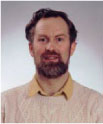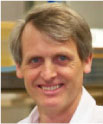BIOPHYSCHEM2011: A Joint Meeting of the Australian Society for Biophysics and the RACI Physical Chemistry Division
Adam J. Trevitt A E , Jeffrey R. Reimers B , Ronald J. Clarke B and Jamie I. Vandenberg C DA School of Chemistry, University of Wollongong, NSW 2522, Australia.
B School of Chemistry, The University of Sydney, NSW 2006, Australia.
C Victor Chang Cardiac Research Institute, NSW 2010, Australia.
D St Vincent’s Clinical School, University of New South Wales, NSW 2052, Australia.
E Corresponding author. Email: adamt@uow.edu.au

Adam Trevitt is a Senior Lecturer in the School of Chemistry at the University of Wollongong. His research focuses on understanding the radical-mediated chemistry dictating combustion and atmospheric processes using laser and synchrotron techniques. He Chaired the BioPhysChem2011 meeting. |

Jeff Reimers is a Professor in the School of Chemistry at the University of Sydney. His research focuses on theory and simulation for Molecular Electronics, including natural and artificial photosynthesis and inorganic–organic interface structures. |

Ron Clarke has been a Senior Lecturer within the School of Chemistry at the University of Sydney since 2003. His major research interests are the biophysical chemistry of biological membranes and ion pumps, in particular the Na+, K+-ATPase. |

Jamie Vandenberg is head of the Mark Cowley Lidwill Research Program in Cardiac Electrophysiology at the Victor Chang Cardiac Research Institute. His research focuses on mechanisms of voltage sensing in ion channels and the molecular basis of inherited arrhythmia syndromes. |
Australian Journal of Chemistry 65(5) 439-441 https://doi.org/10.1071/CH12213
Published: 28 May 2012
This Research Front of the Australian Journal of Chemistry is aligned with the BIOPHYSCHEM2011 meeting, a joint conference of the Australian Society for Biophysics and the Physical Chemistry Division of the RACI, which was held at the University of Wollongong from 3 to 6 December 2011. Just shy of 200 delegates made the journey to the Illawarra as these two societies came together for the first time for a national meeting. The idea for this collaboration sprang from the inaugural Australian Biophysical Chemistry Workshop, coordinated by Dr Ron Clarke (U. Sydney) and Dr Tak Kee (U. Adelaide) in 2010. The success of this workshop, in drawing in members from across the physical chemistry and biophysics communities, inspired this joint national meeting. It was a great success and well supported by members across the communities. The gathering commenced with a 2-day workshop on quantum-chemical computational methods organised by Dr Meredith Jordan (U. Sydney) that attracted 40 students and scientists from across Australia and abroad. The workshop featured ‘masterclass’ tutorials by world leading experts in computational chemistry and biophysics. Files from the workshop can be accessed here: www.biophyschem2011.net.au. The main BIOPHYCHEM2011 scientific program comprised joint sessions of plenary speakers, keynotes and early career researcher-focussed keynotes, and also breakout sessions that ran concurrently. There was certainly a wide scope of science delivered, discussed and debated. Evening poster sessions ended late with the many scientists still engrossed in deep discussion while cleaning staff politely funnelled them out the door. Throughout, it was pleasing and invigorating to see the passion for science and there was a notable relaxed aura to the meeting – possibly the Wollongong influence.
Plenary Lectures were delivered by Professor Martin Chalfie (U. Columbia, Nobel Prize Chemistry 2008), Professor Tim Clark (U. Erlangen-Nuremberg), Professor Kalina Hristova (Johns Hopkins University), Professor Judith Klinman (U. California, Berkeley) and Professor Martin Zanni (U. Wisconsin-Madison). The meeting also honoured three medal winners: Professor Leo Radom (U. Sydney, Physical Chemistry Division Medallist 2010), Professor Keith King (U. Adelaide, Physical Chemistry Division Medallist 2011) and Professor Boris Martinac (Victor Chang Cardiac Research Institute, 2011 ASB Bob Robertson Medal). We are grateful to all our sponsors and to all that supported this meeting. A list of sponsors and other information (including the conference handbook) can be found at www.biophyschem2011.net.au. We especially acknowledge the University of Wollongong, Faculty of Science and School of Chemistry for their support of this meeting.
Research across the physical chemistry and biophysics disciplines is strong and lively in Australia and from the list of submissions in this Research Front there is a notable abundance of young researchers making significant impacts. The multidisciplinary nature of these studies is also a feature, with links connecting basic biological science and applications to physical chemistry processes to nanotechnological applications, and vice versa.
A review paper from Haibo Yu’s group (U. Wollongong) shows how molecular dynamics simulations can be used to synthesise structural and functional studies to probe the fundamental basis of how proteins work.[1] Specifically, they were able to generate plausible models as to how ion-binding sites in the Na+, K+ ATPase are able to switch between being Na+ selective and K+ selective. This is a fundamental problem of relevance for all Na+ and K+ channels and transporters. Based on their simulations and published crystal structures they propose a highly original and enlightening mechanism whereby the switch in selectivity is produced by a conformationally dependent change in protein protonation state, reminiscent of the light-driven proton pump bacteriorhodopsin. This study is an excellent example of how fundamental studies in chemistry and physics can provide insights into biologically important problems.
Louise Brown (U. Macquarie) and co-workers have contributed a paper on processing methods for nanodiamonds containing a single nitrogen vacancy (NV).[2] The presence of the NV renders them fluorescent. Single-molecule fluorescence measurements, developed historically for biological applications, are then employed to probe the interaction between these nanodiamonds and dye molecules. The paper from Tak Kee’s laboratory (U. Adelaide) displays how physical chemistry techniques reveal the properties, including possible anticancer activity, of the biologically active compounds.[3] They report on stability of copper–curcumin complexes and reveal that, in acetonitrile and also in the presence of sodium dodecyl sulfate micelles, decomposition of the curcumin is mediated by the Cu(II) reduction, although the Cu(II)–curcumin complex is stable in methanol.
Solar-cell research is driving scientists to devise schemes to push the limits of efficiency. Much of this work is bio-inspired, adopting molecular components and processes first characterized from photosynthetic reaction centres. Tim Schmidt (U. Sydney) and co-workers report studies incorporating triplet–triplet annihilation photon up-conversion in a solar cell equipped with a back-scattering layer.[4] With this strategy, longer-wavelength photons are converted to shorter wavelengths, exploiting the triplet-state interactions of sensitizer molecules (porphyrins) and emitter molecules (rubrenes). With the additional aid of a backscattering layer, higher quantum efficiencies for the device are reported for long-wavelength photons that would otherwise be wasted in a conventional solar-cell device. Attila Mozer and Tracey Clarke (U. Wollongong) show reduced bimolecular charge-recombination in novel copolymers where charges are photon-generated.[5] Charge recombination in solar cells reduces performance. These results reveal that the suppression of charge-recombination is achievable by tuning the polymer system akin to the way that amino acid mutations tune photosynthesis, and that this, in turn, permits the fabrication of polymer solar cells with relatively thick active layers.
Huang and co-workers (U. Adelaide) considered properties of the MEH-PPV polymer widely used in organic solar cells and other devices using a coarse-grained approach reminiscent of similar methods pioneered to predict and interpret protein structure.[6] This provides great insight into the design of solar cells by connecting device properties to variables such as the polymer chain length, chemical defects, and tertiary structure (morphology). Coote and co-workers (Australian National University) applied techniques that they had developed for understanding free-radical polymerization reactions critical to many chemical industries to the oxidation of hematoxylin.[7] The electrochemical and spectroscopic properties of this substance have an important biological function, as well as providing commercial applications as a biological stain and for cancer detection.
In gas-phase ion studies, Duncan Wild’s group (U. Western Australia) report photoelectron studies and ab initio calculations on bromide–carbon monoxide complexes.[8] It is revealed that the first-electron binding energy is greater for the Br–…CO van der Waals complex than for bare Br–. In addition to quantifying this complex stabilization energy, the Br–…CO complex electron affinity is reported and compared to quantum chemical calculations using various computational methods. Still in the gas-phase and negative ion mode, but for biological structures much further along the m/z axis, the study by Tara Pukala and co-workers (U. Adelaide) utilizes mobility mass spectrometry to distinguish conformations of the protein calmodulin subsequent to Ca2+, or target peptide, binding.[9] Co-existing folded and unfolded conformations were detected and reconcile well with known calmodulin structures. They show that peptide binding to calmodulin involves intermediates that display relatively collapsed structures and demonstrate the utility of performing calibration-based travelling wave mobility mass spectrometry for measuring collision cross-sections in negative ion mode.
A paper contributed by Marc-Antoine Sani and co-workers (U. Melbourne) demonstrates both the complexity of peptide interaction with biological membranes and the power of solid-state NMR spectroscopic studies.[10] The subject of their study was the amyloid-β peptide, involved in the pathogenesis of Alzheimer’s disease. Their results indicate that the peptide penetrates deeply into the lipid headgroup region of the membrane and that the interaction is modulated by the presence of Cu2+ ions. The interactions varied, however, with the lipid membrane composition. Their results, thus, stress the importance of lipid composition in determining biologically relevant interactions and the need to go beyond standard model membrane systems such as one-component phosphatidylcholine lipid vesicles.
Laura McKemmish (U. Sydney) contributed a paper[11] detailing the properties required for a chemical to be useful in an NMR-based quantum computing application. High-resolution NMR techniques were developed to solve problems in biophysical chemistry and can now be applied to drive gates in quantum information processors. This paper demonstrates how well a particular molecule performs when such gates are applied to the patterns of spin-spin coupling constants afforded by different chemical motifs, allowing for the specialty design of molecules for quantum computing applications.
Finally we note the study on diarylmethane and azomethine dyes by Seth Olsen (U. Queensland).[12] This project arose from earlier work that demonstrated the connection between chemical structure and function for green fluorescent protein. However, it became clear that the solution to this problem required a more general chemical understanding pertinent to the function of many dyes used in bioimaging, food colourings, and chemical photography. Olsen presents a unified chemical model for the properties of these important dyes that are also closely related to prominent exciton-transport and charge-transport proteins and materials.
References
[1] H. Yu, I. Ratheal, P. Artigas, B. Roux, Aust. J. Chem. 2012, 65, 448.| Crossref | GoogleScholarGoogle Scholar |
[2] J. M. Say, C. Bradac, T. Gaebel, J. R. Rabeau, L. J. Brown, Aust. J. Chem. 2012, 65, 496.
| Crossref | GoogleScholarGoogle Scholar |
[3] M. H. M. Leung, P. Mohan, T. L. Pukala, D. B. Scanlon, S. F. Lincoln, T. W. Kee, Aust. J. Chem. 2012, 65, 490.
| Crossref | GoogleScholarGoogle Scholar |
[4] T. Schulze, Y. Y. Cheng, B. Fueckel, R. MacQueen, A. Danos, N. Davis, M. Tayebjee, T. Khoury, R. Clady, N. Ekins-Daukes, M. Crossley, B. Stannowski, K. Lips, T. Schmidt, Aust. J. Chem. 2012, 65, 480.
| Crossref | GoogleScholarGoogle Scholar |
[5] A. Mozer, T. Clarke, Aust. J. Chem. 2012, 65, 442.
| Crossref | GoogleScholarGoogle Scholar |
[6] M. Chiu, T. Kee, D. Huang, Aust. J. Chem. 2012, 65, 463.
| Crossref | GoogleScholarGoogle Scholar |
[7] M. Namazian, H. R. Zare, M. L. Coote, Aust. J. Chem. 2012, 65, 486.
| Crossref | GoogleScholarGoogle Scholar |
[8] K. M. Lapere, R. J. Lamacchia, L. H. Quak, M. Kettner, S. G. Dale, A. J. McKinley, D. A. Wild, Aust. J. Chem. 2012, 65, 457.
| Crossref | GoogleScholarGoogle Scholar |
[9] A. N. Calabrese, L. A. Speechley, T. L. Pukala, Aust. J. Chem. 2012, 65, 504.
| Crossref | GoogleScholarGoogle Scholar |
[10] D. K. Weber, J. D. Gehman, F. Separovic, M. Sani, Aust. J. Chem. 2012, 65, 472.
| Crossref | GoogleScholarGoogle Scholar |
[11] L. K. McKemmish, D. J. Kedziora, G. R. White, N. S. Hush, J. R. Reimers, Aust. J. Chem. 2012, 65, 512.
| Crossref | GoogleScholarGoogle Scholar |
[12] S. Olsen, Aust. J. Chem. 2012, 65, 520.
| Crossref | GoogleScholarGoogle Scholar |


